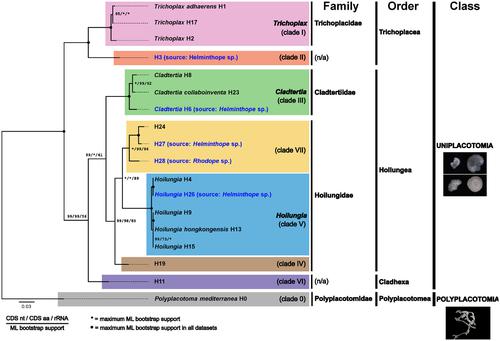当前位置:
X-MOL 学术
›
Ecol. Evol.
›
论文详情
Our official English website, www.x-mol.net, welcomes your feedback! (Note: you will need to create a separate account there.)
Beauty in the beast – Placozoan biodiversity explored through molluscan predator genomics
Ecology and Evolution ( IF 2.6 ) Pub Date : 2024-04-11 , DOI: 10.1002/ece3.11220 Michael Eitel 1, 2 , Hans‐Jürgen Osigus 3 , Bastian Brenzinger 4 , Gert Wörheide 1, 2, 5
Ecology and Evolution ( IF 2.6 ) Pub Date : 2024-04-11 , DOI: 10.1002/ece3.11220 Michael Eitel 1, 2 , Hans‐Jürgen Osigus 3 , Bastian Brenzinger 4 , Gert Wörheide 1, 2, 5
Affiliation

|
The marine animal phylum Placozoa is characterized by a poorly explored cryptic biodiversity combined with very limited knowledge of their ecology. While placozoans are typically found as part of the epibenthos of coastal waters, known placozoan predators, namely small, shell‐less sea slugs belonging to the family Rhodopidae (Mollusca: Gastropoda: Heterobranchia), inhabit the interstitium of seafloor sediment. In order to gain further insights into this predator–prey relationship and to expand our understanding of placozoan ecological niches, we screened publicly available whole‐body metagenomic data from two rhodopid specimens collected from coastal sediments. Our analysis not only revealed the signatures of three previously unknown placozoan lineages in these sea slug samples but also enabled the assembly of three complete and two partial mitochondrial chromosomes belonging to four previously described placozoan genera, substantially extending the picture of placozoan biodiversity. Our findings further refine the molecular phylogeny of the Placozoa, corroborate the recently established taxonomic ranks in this phylum, and provide molecular support that known placozoan clades should be referred to as genera. We finally discuss the main finding of our study – the presence of placozoans in the sea floor sediment interstitium – in the context of their ecological, biological, and natural history implications.
中文翻译:

兽中之美——通过软体动物捕食者基因组学探索长生动物的生物多样性
海洋动物门的特点是对神秘生物多样性的探索很少,而且对其生态学的了解也非常有限。虽然长生动物通常是沿海水域表层底栖动物的一部分,但已知的长生动物捕食者,即属于红皮科(软体动物:腹足纲:异鳃纲)的小型无壳海蛞蝓,栖息在海底沉积物的间质中。为了进一步了解这种捕食者与被捕食者的关系,并扩大我们对长生动物生态位的了解,我们筛选了从沿海沉积物中收集的两个紫红色标本的公开可用的全身宏基因组数据。我们的分析不仅揭示了这些海蛞蝓样本中三个先前未知的长生动物谱系的特征,而且还能够组装属于先前描述的四个长生动物属的三个完整和两个部分线粒体染色体,从而大大扩展了长生动物生物多样性的图景。我们的研究结果进一步完善了扁动物门的分子系统发育,证实了该门最近建立的分类等级,并为已知的扁动物分支应被称为属提供了分子支持。最后,我们讨论了我们研究的主要发现——海底沉积物间质中长生动物的存在——在其生态、生物学和自然历史影响的背景下。
更新日期:2024-04-11
中文翻译:

兽中之美——通过软体动物捕食者基因组学探索长生动物的生物多样性
海洋动物门的特点是对神秘生物多样性的探索很少,而且对其生态学的了解也非常有限。虽然长生动物通常是沿海水域表层底栖动物的一部分,但已知的长生动物捕食者,即属于红皮科(软体动物:腹足纲:异鳃纲)的小型无壳海蛞蝓,栖息在海底沉积物的间质中。为了进一步了解这种捕食者与被捕食者的关系,并扩大我们对长生动物生态位的了解,我们筛选了从沿海沉积物中收集的两个紫红色标本的公开可用的全身宏基因组数据。我们的分析不仅揭示了这些海蛞蝓样本中三个先前未知的长生动物谱系的特征,而且还能够组装属于先前描述的四个长生动物属的三个完整和两个部分线粒体染色体,从而大大扩展了长生动物生物多样性的图景。我们的研究结果进一步完善了扁动物门的分子系统发育,证实了该门最近建立的分类等级,并为已知的扁动物分支应被称为属提供了分子支持。最后,我们讨论了我们研究的主要发现——海底沉积物间质中长生动物的存在——在其生态、生物学和自然历史影响的背景下。



























 京公网安备 11010802027423号
京公网安备 11010802027423号